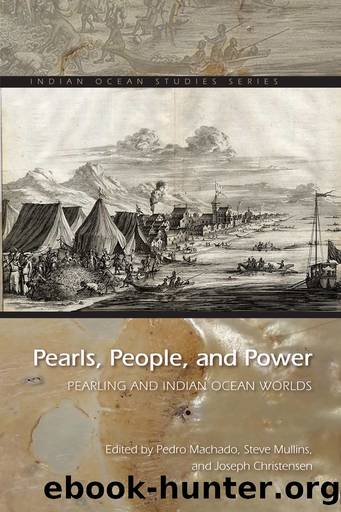Pearls, People, and Power by Pedro Machado Steve Mullins Joseph Christensen

Author:Pedro Machado, Steve Mullins, Joseph Christensen [Pedro Machado, Steve Mullins, Joseph Christensen]
Language: eng
Format: epub
Tags: Nonfiction, History, World History
ISBN: 9780821446935
Publisher: Ohio University Press
Published: 2020-01-27T05:00:00+00:00
SEVEN
Pearl Fishing, Migration, and Globalization in the Persian Gulf, Eighteenth to Twentieth Centuries
ROBERT CARTER
THIS CHAPTER examines the growth of the pearling industry in the Persian Gulf during the eighteenth to twentieth centuries. It takes the pearl fishing communities of Qatar as a detailed case study, especially focusing on migration into and within Qatar, and examines historical and archaeological evidence for changing patterns of consumption and integration with global markets.
Space precludes a detailed account of the long history of pearl fishing in the region, which goes back at least seven thousand years.1 Organized and intensive exploitation is evident by the last centuries BCE and first centuries CE, particularly feeding a voracious demand in the Roman west, not to mention booming markets nearer to home in the Middle East. Following this, pearl fishing remained a mainstay of the regional economy during the Late Antique, Early Islamic, and Medieval periods, and subsequently attracted the interest of the Portuguese overlords of the Gulf.2
Pearl fishing thrived during a protracted period of instability between the late seventeenth and early nineteenth centuries, when competing tribal Arab groups vied for control of the fisheries, some newly arrived to the Gulf from inland Arabia, and some long-term residents of the Arabian and Persian shores. This process was accompanied by the foundation of numerous small and medium-sized towns which were largely or wholly dependent on the pearl fishery for their existence, particularly on the Arabian shore, where the influence of regional and European imperial powers was weak. I have argued elsewhere that this process was stimulated by increasing pearl revenues due to growth of global and particularly Western markets.3
I begin this chapter with an account of the fishery at its peak in the nineteenth and early twentieth centuries; then follow with an overview of the process of migration and coastal settlement foundation, using Qatar as a case study; and finish with an exploration of detailed economic and archaeological data from Bahrain and Qatar, which demonstrate the impact of the pearling boom on the towns, their people, their material culture, and their engagement with global patterns of trade and consumption.
Archaeological work supplies a significant portion of the core data in this analysis, particularly regarding changes in material culture, settlement patterns, and settlement size. Excavated sites and finds provide detailed data which are absent from historical sources, particularly in areas (such as the Persian Gulf) which have relatively scant written documentation. To take an explicit example used in this chapter, while historical economic sources tally the import of âchinaware and porcelain,â the quantified finds from excavations in Bahrain, Qatar, and elsewhere reveal precisely what wares were imported, as well as their origins and in what proportions. Moreover, if the site is well-stratified, so that separate levels (and their associated finds) can be isolated and closely dated, then changes in material culture though time can be identified. In the examples used below, changes in the proportion of imported ceramics are noted and used as a proxy measure of engagement in trading activities and wealth levels.
Download
This site does not store any files on its server. We only index and link to content provided by other sites. Please contact the content providers to delete copyright contents if any and email us, we'll remove relevant links or contents immediately.
Zero to IPO: Over $1 Trillion of Actionable Advice from the World's Most Successful Entrepreneurs by Frederic Kerrest(4296)
Machine Learning at Scale with H2O by Gregory Keys | David Whiting(4183)
Never by Ken Follett(3793)
Harry Potter and the Goblet Of Fire by J.K. Rowling(3775)
Ogilvy on Advertising by David Ogilvy(3511)
Shadow of Night by Deborah Harkness(3303)
The Man Who Died Twice by Richard Osman(2997)
Book of Life by Deborah Harkness(2867)
The Tipping Point by Malcolm Gladwell(2827)
Will by Will Smith(2793)
0041152001443424520 .pdf by Unknown(2784)
My Brilliant Friend by Elena Ferrante(2774)
How Proust Can Change Your Life by Alain De Botton(2742)
Purple Hibiscus by Chimamanda Ngozi Adichie(2652)
How to Pay Zero Taxes, 2018 by Jeff A. Schnepper(2602)
Hooked: A Dark, Contemporary Romance (Never After Series) by Emily McIntire(2502)
Rationality by Steven Pinker(2291)
Borders by unknow(2229)
Can't Hurt Me: Master Your Mind and Defy the Odds - Clean Edition by David Goggins(2228)
